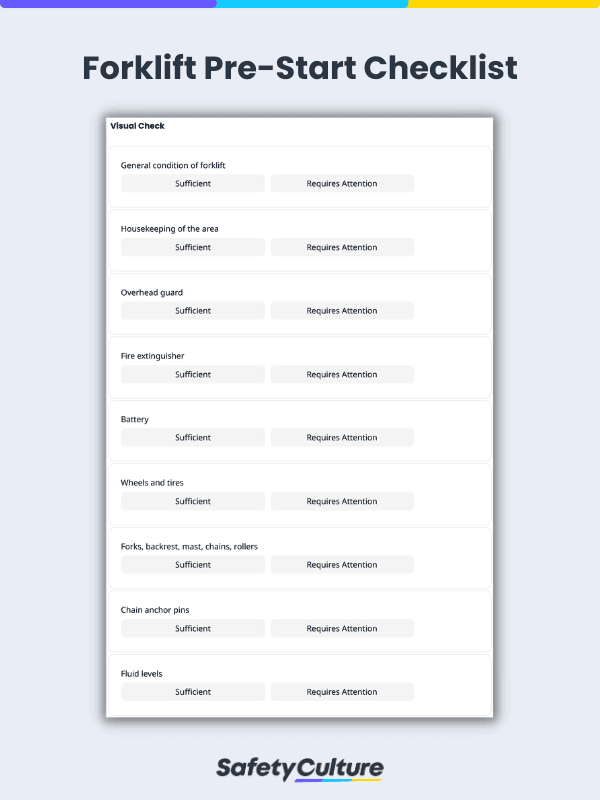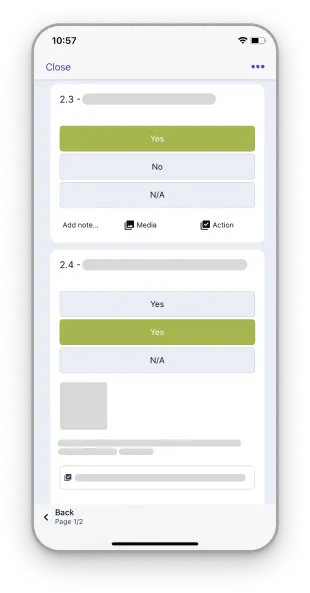What is a Forklift Pre Start Checklist?
A forklift pre-start checklist, also known as a forklift pre-use or pre-operation checklist, outlines all the essential components and systems that must be inspected before operating a forklift. It guides operators in assessing the condition of their forklifts and detecting potential issues that may compromise safety. This way, they can address these problems early on and reduce the risk of accidents, injuries, and equipment damage.
Why is it Important to Perform Pre-Start Checks?
Pre-start inspections are a must for any business that uses forklifts in their operations. First and foremost, they are essential to maintaining the safety, reliability, and life span of the equipment. These inspections can uncover safety hazards or mechanical problems that could compromise the safe operation of the forklift. By detecting and addressing these issues early on, operators can prevent machine breakdowns, equipment damage, accidents, and injuries when at work.
In addition, conducting pre-start checks is a mandatory procedure in specific countries. The US Occupational Safety and Health Administration (OSHA), for instance, requires all forklifts to be inspected on a daily basis before being used in service. The UK’s Lifting Operations and Lifting Equipment Regulations (LOLER) 1998 also stipulates the need for pre-use checks to spot faulty equipment before it can cause damage.
Components of a Forklift Pre Start Checklist
Before using a forklift, operators must first perform a visual inspection and operational check to confirm if the equipment works as intended. This section will outline the essential elements to include in your forklift pre-start checklist:
Visual Check
When visually inspecting the forklift, be on the lookout for the following items:
- General condition of the forklift
- Housekeeping of the area
- Overhead guard
- Fire extinguisher
- Fluid levels
- Battery
- Wheels and tires
- Forks, backrest, mast, chains, rollers
- Chain anchor pins
- Fluid leaks
- Hoses
- Air filter intake
- Signage and stickers (if legible)
- Propane tank (if applicable)
Operational Check
This portion of the pre-use checklist examines if the systems in the forklift are working properly. Here’s a quick overview of the systems to pay attention to during operational tests:
- Engine
- Gauges / Horn
- Headlights and warning lights
- Seat belt
- Steering wheel
- Tilt / Sideshift
- Brakes
Recommendations and Confirmation
This section allows operators to state their findings during the visual and operational checks. They can confirm if the forklift is safe to use and provide any subsequent action in case the forklift requires immediate attention. Once done, they can affix their signature alongside their supervisor’s.
How to Perform a Forklift Pre-Operation Check using a Checklist
Now that you have created a forklift pre-start checklist, let’s walk through the steps of using it for your pre-operation inspections:
- Review the checklist – Before starting the inspection, familiarize yourself first with the items in the checklist and ensure you understand each point.
- Prepare the necessary tools – Gather all the tools or equipment needed to conduct the inspection, such as tire pressure gauges, flashlights, and battery testers.
- Begin with a visual inspection – Start the pre-operation check by visually examining the forklift as outlined in the checklist. See if the tires, forks, masts, backrests, chains, and rollers are in good condition, and take note of any issues or defects.
- Check the fluid levels – Proceed to evaluate if the fuel, oil, and battery levels are at appropriate levels.
- Test the controls and instruments – Examine the steering wheel, brakes, gauges, indicators, and other controls for proper functioning. Ensure that they’re all responsive and in good condition.
- Assess the lifting and tilting mechanisms – After the forklift controls, test the tilts, side shifts, and similar mechanisms to evaluate their performance. Pay attention to any leaks, unusual noises, or jerky movements.
- Inspect the safety components – Verify the condition of the seat, seatbelts, lights, and other safety features.
- Confirm if the forklift is safe for use – Based on the information gathered during the pre-start inspection, determine if you should proceed with operating the forklift.
- Document your findings – Note any observations, malfunctions, or maintenance requirements identified in the pre-operation check. This information serves as an excellent reference for future repairs or maintenance tasks.
- Designate corrective actions – If any issues are found, follow the right procedures to address them. Some steps you can take include notifying your supervisor, scheduling repairs, or contacting the maintenance department.
Upon sign-off and completion, here’s a sample forklift pre-start check report for your reference:
Forklift Pre-Start FAQs
The operator or driver is primarily responsible for checking the forklift prior to its use as part of their duty to ensure its safe operation. Managers or supervisors can oversee the completion of these pre-start inspections to ensure compliance and address any identified issues. They can utilize forklift pre-start checklists to speed up this process of them.
Pre-start checks for forklifts should be performed before each use or when a different operator takes control. Regularly inspecting the forklift helps catch potential issues and protects drivers from accidents and injuries caused by malfunctioning equipment.
No, checklists are not mandatory when conducting forklift pre-operation checks. Nonetheless, they are valuable tools for standardizing inspection procedures, reducing the risk of overlooking critical safety aspects, and complying with forklift safety regulations.




